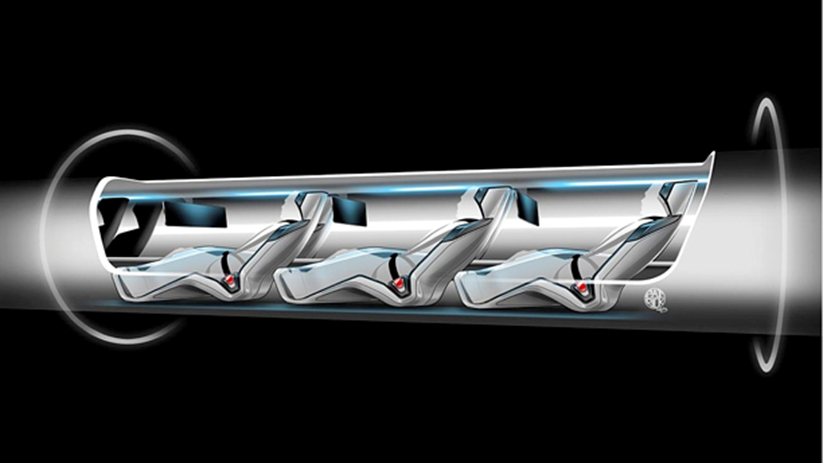There are plenty of nay-sayers who are already shoveling dirt on Elon Musk’s proposal that someone or some entity take up the design for a high-speed conveyance he is calling Hyperloop to create a 30-minute trip between San Francisco and Los Angeles.
Hyperloop, a high-speed solar/electromagnetically powered “train” concept that would travel in an enclosed tube at speeds of more than 700 miles per hour, is the first true 21st century transportation plan that we have seen proposed by anyone. Musk is the founder of Paypal, Tesla Motors and SpaceX, and has a track record of disrupting established industries.
USA Today carried a story by Chris Woodyard headlined: “Why Elon Musk’s Hyperloop Won’t Work”. The newspaper quotes the Navigant Research blog: “The biggest concern with this plan has to do with temperature. The pod will be compressing air and expelling it downwards and backwards. All that air compression creates an enormous amount of heat, which can damage the pod and its machinery.”
Eleazar David Melendez writing for HuffPost Tech quotes Zafar Khan, analyst for French Bank Societe Generale, who follows train and airplane manufacturers: “Ignoring the physics of it, to make it viable, pricing would have to be astronomical to have a reasonable payback period.”
Khan continued: “You will remember the grand Eurotunnel project and what a mess that became. The Eurotunnel project devolved into a slew of lawsuits after revenue projections turned out to be far too optimistic, writes Melendez.
Is Eurotunnel really the right comparison, though? Musk’s notion is that the elevated tube carrying passengers between San Francisco and LA be built alongside the highway, thereby eliminating the need for complex real estate acquisition. The land is presumably already owned by the State of California. Given the state’s occupation with green projects, one would think that the state that gave us HOV lanes and the zero-emission-vehicle tax credit and the California Air Resources Board [CARB] would be cooperative.
The Eurotunnel, on the other hand, involved the governments of two countries, countless unions and the engineering feat of digging under the English Channel.
Musk came forward with the Hyperloop plan, suggesting a $6 billion price tag, compared with the $70 billion price-tag for a high-speed rail project (surely to balloon to $100 billion in real terms) when he saw the obvious waste in that plan. Why $100 billion? Because politicians who will greenlight the project see it as an enormous opportunity for patronage to supplier companies and unions. Why opt for a $6 billion project (that would probably balloon to $10 billion when you can get $100 billion approved with Federal money involved?
Musk says that he is hoping that the project gets built by someone working off his company’s scheme.
“… it’s kind of like a open source design that maybe you can keep improving. And I don’t have any plans to execute, because I must remain focused on SpaceX and Tesla,” Musk said on a Tesla Quarterly Earnings call.
Melendez also criticizes the Hyperloop schematic for suggesting a per passenger load of 220 pounds at a time when Americans are getting heavier, not thinner. Okay, but the schematic can be changed to allow for seats wider than 27 inches and to handle more weight. Some engineers are saying that the elevated tube will also be prone to problems from wind. Okay, build it closer to the ground. The point is that these things can be fixed without killing the idea.
And forget Musk’s notion that cost would be in the area of $20. That’s nuts. A round trip airline ticket between San Francisco and Los Angeles with a few weeks notice costs $196 booking via Orbitz.com. This frequent traveler would gladly pay $300 to make that trip in 30-minutes without having to deal with airports, taxis and the crotch-groping TSA. That’s a no-brainer. Big business, which pays hundreds of dollars more for plane tickets every day would pay the same and more to save time.
And then there is The Onion, which perhaps rightly suggests that the Hyperloop could be powered by the energyfrom screaming passengers going over 700 mph in an enclosed tube. Then again, talk to my 11-year old son who began riding the highest, fastest roller coasters as soon as he was deemed tall enough, and he’d tell you there is a market for fast, reliable, hassle free travel even at that speed.
Of all the reasons I am reading about why Hyperloop won’t work, the biggest one is that it is a potentially cheaper, less energy-dependent project to advance the way the country thinks about mass-transit and inter-city travel. Labor unions and corporate interests that would benefit more from a series of $100 billion high-speed rail systems peppered around the country will pressure politicians to blow off the cheaper, cooler, more energy-efficient, modern solution.
Why enter the 21st century when the 20th is still more profitable for business?
If the project advances, it will surely be a public-private partnership of some kind. Will Amtrak take it on? Not likely. It is also unlikely that the House of Representatives in Washington, D.C., would appropriate funds given that “infrastructure” has taken on similar status in the halls of Congress as “gas taxes” and “Obamacare.”
It could be just me, but Musk is probably the only one around with enough skills, moxie, angst, vision and disruptive thinking to get it done. I hope he changes his mind. The country will be better off being shown that Hyperloop can work than it will be if Musk sells more of his $80,000-$100,000 Tesla electric cars.



